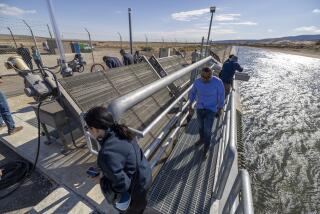Kartchner Caverns Worry Experts
- Share via
TUCSON, Ariz. — A year after Kartchner Caverns opened, tourists bubbling with anticipation line up in capacity numbers to view the new state park’s intricate calcite formations, some of which are 500,000 years old.
“It’s not uncommon for people to cry when they see these things. I’m talking tears of joy,” said Arizona State Parks Director Kenneth Travous.
Since the Rotunda and Throne rooms opened for viewing in November 1999, there have been 179,000 visitors through October, almost 500 a day in groups of 16 to 20, generating about $3 million in revenue.
But a number of caving experts, as well as the men who discovered the caverns and even Travous, are concerned about the future.
They’re debating whether the underground complex is drying out, and if so, whether that stems from recent drought conditions or some structural problem--perhaps created by construction to prepare the caverns for public viewing.
The Parks Department spent $28 million to develop Kartchner Caverns, building air locks and taking other measures to retain the caves’ moisture.
The moisture is vital to the appearance and continued growth of the brightly colored rock formations in the 2 1/2-mile cavern complex, which is said to rival New Mexico’s Carlsbad Caverns in beauty if not size.
Data earlier this year showed a drying trend. Late summer rains and one of the wettest Octobers on record momentarily tempered concerns.
Travous said the rains helped push the humidity up and the temperature down, and the evaporation is back to what it was before the opening. But he noted that environmental challenges will always be present.
“What is the effect of opening the cave?” he said. “Where are we seeing the effects from it being open versus the effects of this dry period up until a month or two ago?”
Cavers Randy Tufts and Gary Tenen, who discovered the caverns in 1974 and were instrumental in getting the state to buy them, criticized Travous’ agency in September. They said the parks department had mishandled environmental data and failed to do follow-up studies on changes observed.
Travous said then that it came down to interpretation of data and that Tenen, Tufts and Bob Buecher, who conducted a decade-old baseline study of the caverns’ humidity and temperature, were viewing it differently than he was.
Last March, Travous brought in Ron Kerbo, the National Park Service’s national cave management coordinator, for consultation. Kerbo suggested adjustments, such as decreasing the intensity of lights in the cave.
He questioned the efficiency of an automated data-monitoring system, was critical of a misting system because of the water’s pH and voiced some concern over airflow analysis.
Buecher said he believes the problem could be structurally related, perhaps a crack or crevice created during tunnel construction, allowing an airflow. Kerbo agreed.
Travous has adopted some of Kerbo’s suggestions, including looking for a full-time cave resources specialist to interpret and act on the data collected.
Kerbo also recommended creation of a science advisory board to assist the cave specialist it hires.
Kerbo said he believes there is “a very good chance that these problems can be turned around . . . that they can mitigate many of the things we have seen over the first couple of years. I’m guardedly optimistic that the patient is going to do fine.”
He said the state appears determined to correct any problems. “Otherwise they wouldn’t have invited me in and be taking these steps,” he said. “I see that as a very positive thing.”
More to Read
Sign up for Essential California
The most important California stories and recommendations in your inbox every morning.
You may occasionally receive promotional content from the Los Angeles Times.













